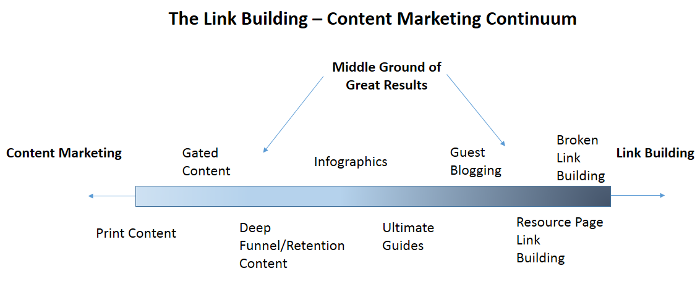Link building is as relevant as ever for today’s digital marketers.
In fact, you could say content and backlinks are the most important aspects of any SEO strategy.
Today you’re going to learn everything there is to know about backlinks. As a bonus, I’ll even share 10 of my link building techniques that are working right now.
Let’s get started incorporating link-building into your marketing strategy.
Why Links Are Important for SEO
Google’s Webmaster Trends Analyst Gary Illyes made a statement in October 2018 that Google finds content via links and sitemaps, in that order.
Ultimately, links are how search engines are able to understand the web. That’s why it’s important that your site includes internal links to the pages you want Google to find on your website and also that you earn reputable external links pointing to your site. Google discovers new content by following links, and it also uses links as a signal for how well websites should rank.
Links Can Help Your Content Rank on Competitive SERPs
As keywords become more competitive, ranking a page based on the merit of its content alone becomes more difficult. Marketers are aware of how effective content is when it gives searchers the information they want, and this has created a ton of competition in many industry niches. At a certain point, there’s just already too much good content about a topic. You can’t be certain that making content longer or more detailed will ensure its ranking improves. If your niche is saturated, you can create amazing content yet still find your site sitting on the second page and beyond.
Trying to rank higher can be frustrating, but it’s not futile.
A high quality backlink profile can give your site the extra boost it needs to outrank similar content. Marketers should therefore consider link building efforts in conjunction with their content efforts. As Moz’s Beginner’s Guide to Link Building states, “It is generally accepted that if all other factors are equal, the volume and quality of links pointing to a page will make the difference between rankings.”
In a perfect world, your high-quality content would attract links naturally, and you’d never have to think about link building. This passive approach is what Google recommends.
Yet the reality is that many marketers take link building into their own hands and turn it into an active effort.
That’s why I wrote this guide to share my experiences with link building and what has worked for me and my team.
Now, let’s go over what makes a good link and answer some common questions so we can start getting deeper into link building.

What Makes a Link Good for Your Search Engine Ranking?
Not all links are created equal. Google has updated its algorithms many times over the years to improve the quality of results that users see, and it is now quite difficult to game the system and get your site to rank via the quantity of links alone. The perfect link is on a high-quality website, labeled with relevant anchor text, and followed (as opposed to having the nofollow attribute). Let’s break down what each of these 3 things means.
- On a high-quality website: The best links come from sources that search engines trust. Google looks at whether a website has a backlink profile that suggests authoritative sources are giving it a vote of confidence. For instance, affiliation with a government or university website lends legitimacy to a company, so links from these sources are often beneficial. A variety of SEO tools assess a website’s quality based on its backlink profile, often assigning a score of trustworthiness.
- Labeled with relevant anchor text: You don’t have control over links that aren’t on your own site, and it can be hard to get a webmaster or editor to use the exact keyword phrase you want in the anchor text. You can always try to recommend anchor text if you have a good relationship with the contact, but most likely, a relevant link will be used in the right context and have relevant anchor text anyway. Anchor text also matters for your website’s internal links, and luckily, that’s where you can control it. Think of anchor text as a label that tells the search engine what it should see when it follows the link.
- Followed: By default, all links on indexable websites can be followed by Google and are factored into how it evaluates a site’s backlink profile. However, webmasters can add the rel=nofollow attribute to a link, which instructs Google not to follow it. When building links, you generally want to get followed links. You can right click on a link and select “Inspect Element” to view the code and check whether it has the rel=nofollow attribute or not.

What Makes a Bad Link?
There are some types of links you want to avoid in your backlink profile—or at least, you want to avoid them in large quantities. A few toxic backlinks won’t hurt, but thousands may result in a penalty. SEMrush has SEO features that include alerting you to whether a link is considered toxic when you run an audit on your site. You can also look for other signs that a link is bad. For instance, does the site look like a spammy directory? Is it blank when you try to visit it? Some black hatters target websites with spam links in an attempt to get them penalized, so you need to be vigilant.
If you’re concerned about toxic backlinks, you can try to request removal from the site owner. This may not be successful, but luckily, you can disavow links using Google Search Console. This tells Google to ignore these links when judging your backlink profile. SEMrush has a tool to disavow backlinks, but it needs to be connected to Google Search Console.
Can Nofollow Links Help SEO?
Many marketers hate to get nofollow links, but sometimes whether a link directly impacts your site’s Google ranking isn’t the only thing that matters. A prominent link to your website on any popular site can give you brand exposure and also drive referral traffic. These are definite benefits of high-quality links that don’t go away just because the link isn’t followed.
Some marketing influencers make the bold statement that links with the nofollow attribute can help a website’s SEO. SEMrush published an opinion piece that described in a case study in which a site’s performance improved after the placement of an advertisement link with the nofollow attribute. Moz posted a Whiteboard Friday describing how activities like engaging in social media discussions and answering questions on Quora can be extremely valuable for SEO. How exactly? The brand visibility that comes from these activities can lead to naturally earning followed links. So, you shouldn’t completely write off marketing efforts just because they won’t directly result in followed links.
Why Do Some Websites Use Nofollow on External Links?
Often, website owners choose to use nofollow on links when they are concerned that people are trying to game the system. For instance, Wikipedia is a highly authoritative source, and its citation links have the nofollow attribute across the board, and this discourages spam by black hat marketers. The comments sections of blogs are also notorious for link spam and tend to use nofollow by default (but this doesn’t stop people from spamming them).
Sites like Forbes and Entrepreneur whose writers have come under criticism for taking bribes to include links in their articles have instituted widespread nofollow policies. A common criticism of these policies is that websites should pay more attention to the trustworthiness of the links they publish rather than using nofollow.
Is Link Building White Hat? What Google’s John Mueller Said in 2018
On October 3rd, 2018, John Mueller of Google responded to a thread on the Webmaster Central Help Forum and stated:
…if *you’re* making quality links to your site, then that would be considered against our webmaster guidelines, and by that, those links would definitely not be considered “quality”.
This quote was met by much controversy. Was John implying that all active link building efforts are against Google’s guidelines? Or was he referring to the black hat practice of creating a network of sites in order to place links on them? Some marketers were frustrated by the suggestion that seeking out links to your content isn’t a white hat SEO tactic, while others felt that John’s statement only clarified what they already knew. Ultimately, you don’t want Google to catch you engaging in any type of link building practice that is unnatural.
So, Is Link Building Against Google’s Rules?
Google frowns upon creating private blog networks (PBNs), trying to gain links by using spam, and paying for followed links. If a link is paid, Google doesn’t want it to pass PageRank, so they advise advertisers to use the nofollow attribute.
A tactic such as reaching out to bloggers to let them know your content may be interesting to their readers doesn’t fall into the same category. If a certain link building tactic leaves you feeling uncomfortable, then it’s best to just avoid it. There are plenty of white hat ways to gain links by creating genuine connections. Developing relationships with people like bloggers and columnists is a great place to start, and this approach should be entirely in line with Google’s guidelines. If you’re ever unsure about a link building tactic, you can review Google’s guidelines regarding manipulative links under their Search Console Help section.

How to Do a Link Audit with SEMrush
Before you put time and energy into your link building strategy, it’s good to know where your site currently stands. Miles IT uses SEMrush for our marketing clients and have found it to be successful for performing link audits and measuring the trustworthiness of websites.
We conduct an SEO audit for our clients which helps uncover backlink opportunities
The SEMrush Backlink Audit tool can tell you how many sites are linking to your website (or any website). You can also see your backlinks in Google Search Console, which might capture some links SEMrush doesn’t, so it’s best to reference both sources. SEMrush will reveal how many followed links versus how many nofollowed links are going to your site. Additionally, it will show the anchor text that is used when sites link to you.
Identifying Your Website’s SEO Competitors
Before using the Backlink Audit tool, you should identify the site’s main competitors. Three to six is a good amount. The competitors should be competing for the same keywords as your website. The SEMrush Competitor Discovery tool shows you what websites are ranking for keywords you include in Position Tracking projects. If the competitors that show up are too irrelevant, it’s possible that you are not going after the right keywords. You can also conduct manual research to find competitors for a competitor link audit. Manual methods include doing your own research or asking the client what their competitors’ sites are.
For a competitor link audit, your focus should be on the website’s competitors in organic search (other sites trying to rank for the same topics as you) rather than the business’s competitors in general. If a competitor’s site is not performing as well organically as yours, it shouldn’t be as high of a concern, and the information you get from the link audit won’t be as valuable.
The Page Scores and Trust Scores SEMrush calculates can help inform you whether a competitor has a stronger backlink profile than yours; ideally, you want to analyze websites that have a higher score. Score numbers are out of 100, and while they aren’t a perfect science, they can give you an idea of a site’s backlink quality.
Exporting Lists of Links from SEMrush
Once you’ve identified competitors, you can run a link audit for your own site as well as each competitor using the SEMrush Backlink Audit Tool. These lists can all be exported into spreadsheets.

You can also go to the Prospects Report in SEMrush and export the list of recommended link opportunities. There may be irrelevant sites in the mix, so this list should be refined manually before you incorporate it into your strategy.
Using the SEMrush Backlink Gap Tool
The Backlink Gap tool in SEMrush allows you to compare up to 5 competitors’ sites to yours at once. This is similar to using the Backlink Audit tool on competitors but makes it easy to identify commonalities shared by competitors and gaps in your own links by comparison. If you sort by links from the highest authority sites, you can get an overview of high-value links that appear in your competitors’ profiles but not your site’s. You can also export this list.
10 Tactics for Link Building That Really Work
So, you’ve audited your backlinks, and you know there’s room for improvement, but what can you do about it? Like anything in SEO, link building doesn’t just happen by magic. It requires work, patience, and flexibility. People need a reason to add your link to their website. What value does linking to you offer their visitors? Why should they desire a relationship with you? Sometimes, you can do everything right and still find it difficult to convince people to link to you, so it’s best to diversify the tactics you use. You can never be certain which efforts will succeed until you try them.
Here are 10 link building techniques that are sure to yield results when used in conjunction with other marketing efforts.
1. Make “Link-Bait” Content
If you make really great informative resources, the links may come on their own if people find the content and it’s worth sharing! Certain types of content spread naturally because they are helpful or interesting to users. However, in most cases, active outreach is required to meet your link building goals, so you should notify bloggers, journalists, and relevant websites about your content. Tools like BuzzStream that enable mass emailing are helpful for identifying link opportunities as well as performing link outreach.
2. Find Directories and Submit Links
Directory links are not as high value as resource page links, but being listed in relevant directories does indicate to search engines what your site is about. Plus, people search directories for information, so listings may result in referral traffic.
3. Find Sites with Resource Sections and Submit Your Content
Websites that have resource sections present an excellent opportunity for link building. Maybe the resources section has links to services such as the one your site offers, or maybe it links to relevant content that would be helpful to users. This is where link-bait content like comprehensive guides to a topic comes in handy.
4. Use Social Media to Connect with Bloggers and Journalists
Certain social channels may not drive a lot of traffic to your website, but they could still be valuable for your marketing. Twitter, in particular, is a common example of this. Many bloggers and journalists are on Twitter searching for content and participating in conversations. Building relationships with these people and publications gets you on their radar, making them more likely to think of you when they need a story or a piece of content to reference. Social media platforms can also be a place where you actively discuss link trades.
Quick tip: If a person (or company account) jumps into a conversation with you and shares good information, why not offer to quote it on your site with their link in exchange for one to your site?
5. Use Cision to Find Publications and Perform Outreach
Cision is a platform for press release distribution and pitching ideas to journalists that can be very helpful for building editorial links. Using Cision, you can find lists of publications and editors in your industry and send them outreach emails notifying them about news, ideas for stories, and content they may be interested in linking to.
6. Get Links from Local Organizations
Links from local organizations can be valuable for local SEO. If you have participated in your local community in any way such as by volunteering or sponsoring events, reach out to the organizations and ask for a link. You can reciprocate links to these organizations by creating a page like “In Our Community” that links to local organizations you’ve donated to or worked with.
7. Get Links from Your Partners and Customers
You already have relationships with your partners and customers, so why not take advantage of those relationships and do a mutual link exchange? This is low hanging fruit, so go for it!
8. Try Link Reclamation
Link reclamation is an easy way to give your backlink profile a boost. This involves performing outreach to websites that are mentioning you without linking to you (known as “linkless mentions”) or that have broken links to your website. The goal is for the webmasters to update the links to working links to your site, resulting in additional backlinks and potential referral traffic.
9. Find Broken Links to Replace With Yours
Another way to take advantage of broken links to boost your backlink profile is by finding broken links to other websites and getting those links replaced with your links. Say your competitor made an eGuide that is linked from a resources page, but that the link is broken. As part of your link building efforts, you would perform outreach to that website in an attempt to get a link to your website and eGuide instead.
10. Find Opportunities from a Competitive Analysis
Your competitor’s backlink profiles are a valuable source of link building ideas, and SEMrush’s Backlink Audit tool is very helpful for finding inspiration. What types of authoritative sites are giving your competitors links? Are there opportunities for you to get links from the same sites for free? You can also use SEMrush’s Prospects Report to find ideas.
How will you know when you get a link? Well, you can set up Google Alerts for mentions of your website and its brand names. You can also check your backlink profile using Google Search Console or SEMrush. Keep in mind that these tools take time to pick up new links.
Link building is certainly challenging, but when done right, it can be advantageous for your business’s website. What are some of your favorite tactics for link building? Where do you think marketers should focus their efforts? Feel free to share in the comments!
Getting Link Building Help for Your Business
Miles IT is a nationwide business technology company that helps companies boost their visibility on search engines through marketing tactics like link building. We’d be happy to give an assessment of your website and identify opportunities for improving your backlink profile as well as other aspects of your SEO.
Contact us if you’d like to talk to a marketing expert.




he importance of SEO in this day and age could not be more prevalent. Neglecting to apply SEO strategies to your website may be as crippling for your business as locking your front doors. So what does SEO do? In a world where most consumers use search engines to find nearby companies, SEO is the difference between being visible or invisible. Here are 5 reasons why SMB’s should use SEO today. The traffic going to your website is driven mainly by search engines. Simply putting up a website is not enough to get seen; people have to know you exist in the first place. Every time they use Google or another search engine to find their new job, designer handbag, car repair (or anything else), Google uses special algorithms to determine which websites will show up on the front page. By using certain SEO strategies, you can be one of the first sites to pop up every time someone needs something related to your business. Without SEO, you will be buried beneath a mountain of competitors.
I think other website proprietors should take this website as an model, very clean and fantastic user friendly style and design, as well as the content. You’re an expert in this topic!